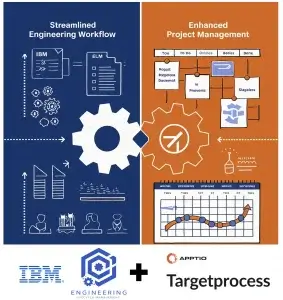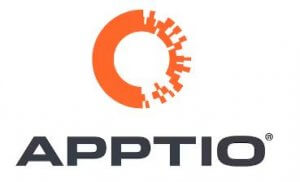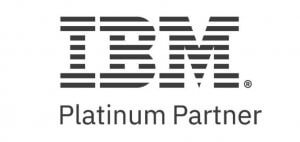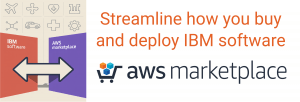Enhancing Agile Engineering with an Integrated IBM Targetprocess and IBM ELM Solution
The IBM Targetprocess and IBM Engineering Lifecycle Management integrated solution pave the way for enhancing agile engineering. This synergy optimizes workflow and integrates complex systems solutions, underscoring the importance of advanced project management tools in achieving greater efficiency.
In this post, we explore the functionality of IBM Targetprocess and the capabilities of IBM Engineering Lifecycle Management, and how they provide an integrated full lifecycle approach to Strategic Planning, Program Management, Resource Management, and Portfolio Budgeting. This not only improves results of engineering processes but also increases the ability of organization-wide leaders at all levels to plan and align strategic objectives, work, resources, and execution.
Understanding IBM Targetprocess
IBM Targetprocess, an Apptio product now under the IBM umbrella, serves as a great option for organizations aiming to enhance business agility. This tool is not just about managing engineering programs but about transforming how organizations align their technology investments with their strategic goals.
Key Features and Functionalities
Support for Various Methodologies: Whether it’s Scrum, Kanban, or SAFe, IBM Targetprocess is adaptable to various standard or custom agile methodologies, providing tools that are tailor-made to fit the unique needs of an enterprise.
Enhanced Visibility and Collaboration: The platform excels in offering visibility across all levels of work and integrates objectives and key results directly with ongoing projects, enhancing collaboration across teams.
Strategic Benefits
Agile Transformation: IBM Targetprocess is instrumental in driving agile transformation at the program, portfolio, and enterprise levels within organizations, helping them become more adaptive and responsive to market changes.
Waterfall Projects or Lean Portfolio Management: With features like strategic reporting and timesheet management, it aids in high-level strategy planning and project/portfolio management, ensuring alignment with business objectives.
Integration and Flexibility
Extensive Integrations: IBM Targetprocess supports integration with major tools like IBM ELM, Jira, Azure DevOps, and more, facilitating a seamless workflow across different tools used within the organization.
Customization and Scalability: IBM Targetprocess stands out for its high customizability and scalability, which allows it to serve a wide range of business sizes and types, from IT operations to human resources and beyond.
IBM Targetprocess not only provides visibility to all project or product development work but also aligns the work closely with strategic business outcomes, making it an excellent choice for organizations looking to leverage agile methodologies at scale.
Exploring IBM Engineering Lifecycle Management Capabilities
IBM Engineering Lifecycle Management (ELM) is recognized for its comprehensive approach to managing intricate system requirements across the entire product development lifecycle. The capabilities in IBM ELM, including the capabilities in IBM Engineering Workflow Management (EWM), work in concert to support complex systems development. Here’s an in-depth look at the key components and functionalities of IBM ELM:
IBM Engineering Requirements — DOORS Next
Requirements Management: Designed to match the paradigms of requirements engineering, facilitating effective management of both high-level and detailed requirements.
IBM Engineering Test Management
Test Procedures and Traceability: Offers robust linking and traceability features, crucial for maintaining coherence between requirements and test cases.
IBM Engineering Workflow Management
Project Collaboration: Enables users to collaborate effectively on projects, with notifications for amendments in the development lifecycle.
Task Tracking and Coordination: Supports business processes and helps in tracking and coordinating tasks efficiently.
Advanced Features and Integration
Digital Thread: Connects dependencies and relationships among various engineering data, automating tasks and enhancing productivity.
Global Configuration Management: This capability enables organizations to efficiently manage configurations of interconnected product components and streamline lifecycle activities, facilitating the management of complex product variants and versions, ultimately leading to faster time-to-market and reduced costs.
Enhanced Reporting: The latest release improves reporting capabilities, allowing for detailed insights into Rhapsody models and traceability with requirements, tests, and work items.
Performance and Scalability
Support for Extensive Engineering Projects: Capable of handling projects with up to 35 million artifacts and 10,000 components, demonstrating significant scalability.
Compliance and Customization
Flexible Change Management: Offers flexible change management options against a single source of truth, accommodating various project paces and steering requirements.
Customizable Workflows: Allows organizations to tailor workflows to their specific needs, enhancing compliance and efficiency.
IBM EWM (as part of the overall IBM ELM solution) not only streamlines processes but also ensures that engineering teams can deliver smart, safe, and cost-effective product solutions. IBM EWM is pivotal for companies aiming to enhance agility and innovation in product development.
How Integration Enhances Agile Engineering Visibility
The integration of IBM Targetprocess with IBM EWM enhances agility in engineering to Enterprise Agility by combining the strengths of both platforms. This synergy allows for a more efficient management of large-scale product development projects, particularly those adopting a lean agile approach. Below are the key enhancements brought about by this integration:
Real-Time Data Sharing and Visibility
Synchronized Information: Work Items such as features and user stories, whether created in IBM Targetprocess or IBM EWM, are kept synchronized across both platforms, ensuring that all team members have access to the latest updates.
Enterprise-Wide View: IBM Targetprocess (when integrated with IBM ELM) provides a holistic view of progress and status across the organization, crucial for strategic decision-making and forecasting.
Strategic Planning and Execution
Visual Roadmaps: Business users, product management, and release train engineers utilize Targetprocess’s intuitive visual interface to create and manage visual roadmaps at the program, product, solution, or portfolio levels.
PI Planning Support: During Planning Interval (PI) planning sessions, work is effectively broken down, and dependencies are visualized and resolved, enhancing the clarity and execution of solution development.
Enhanced Collaboration and Efficiency
Automated Processes: Integration supports automated build, test, and deployment processes, which minimize manual effort and promote consistent, repeatable operations.
Real-Time Collaboration: Teams can collaborate more effectively thanks to real-time updates and shared access to project data and analytics.
Scalability and Security
Handling Complex Programs: The integrated system supports scalability, managing programs of varying sizes and complexities without compromising performance.
Robust Security Features: Enhanced security measures such as data encryption, access controls, and audit trails are implemented, safeguarding sensitive information.
This integration not only streamlines workflows but also empowers teams to track progress, identify risks, and adjust strategies more effectively, thereby driving agile transformation and innovation in program management.
Final thoughts
The collaborative environment fostered by the integration of IBM Targetprocess with IBM ELM aids in streamlining program management and operational efficiency. This synergy not only facilitates a flow of information across various development stages but also aligns with strategic business outcomes, offering a blueprint for driving agile transformation at scale.
The convergence of IBM Targetprocess and IBM ELM elevates the standards of visibility of work, resources, and execution, setting a new benchmark for excellence in agility. It encapsulates a forward-thinking approach to tackling complex development projects, ensuring that organizations can remain adaptive and responsive to market changes.
Ready to take the next step?
Whether you’re looking to improve efficiency, enhance product quality, or accelerate your product development cycle, 321 Gang has the expertise and tools you need to succeed. Let us help you unlock the full potential of your product development process with a lean-agile approach.
Contact 321 Gang today to learn more about how we can help you achieve a competitive edge through lean-agile transformation. Embrace the future of product development with 321 Gang as your trusted partner.
By Tom Hollowell | 321 Gang
*Thanks to Samit Mehta of 321 Gang for significantly contributing to and improving this blog post. Your expertise is greatly appreciated.



321 Gang | 14362 North FLW | Suite 1000 | Scottsdale, AZ 85260 | 877.820.0888 info@321gang.com
The Future is Now
We have helped our clients:
- Reduce development costs by 50-60%
- Accelerate time to market by 20-40%

